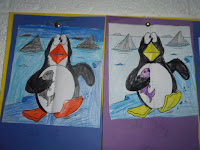Today we used a balance to find the weight of common objects using non-standard units of weight (cubes, pencils and lollipop sticks).
Welcome to 2nd Class, Room 9. We have 22 children in our class - 8 girls and 14 boys. We work really well together and are great friends. Remember to click on photos to see them enlarged.
Monday 30 January 2017
Friday 27 January 2017
Water investigations and the Water Cycle
We have been learning a lot about water (and water pollution, weather and the water cycle).
Today we did some water investigations and some water demonstrations.
First of all we did a water cycle demonstration.
We half filled a cup with water, and marked the level on the cup.
We covered this with cling film and left it on the radiator.
We hoped that some of the water would evaporate, that the water vapour would hit the cling film and would condense into water droplets, and that it would fall again as drops of water (precipitation).
We left the water on the radiator, and by home time we could see the water cycle in action.
We were very impressed!
Making a cloud
We can make our own clouds in a bottle.
You need to put cold water into a bottle, then empty it out again.
Light a match and drop it into the bottle.
Squeeze the bottle.
Nothing happens.
When you stop squeezing the bottle, hey presto, you have a cloud in the bottle.
How does this work?
Clouds are formed when water droplets in the air cool and then collect on dust particles. In this demonstration, the dust particles were provided by the smoke from the match. The air inside the bottle was cooled by releasing the pressure after the bottle was squeezed.
We were delighted to be able to make our own clouds!
Diving and resurfacing jellyfish
A water investigation:
Can we get a jellyfish to sink, and then resurface?
Teacher has a jellyfish.
When we put it in a bottle of water it floats.
We think that this is because the head of the jellyfish is full of air.
Teacher wanted us to get the jellyfish to sink to the bottom and to resurface again.
What could we do?
We could shake the bottle, push the jellyfish with our fingers, roll the bottle, tilt the bottle OR ???
We figured that if we squeeze the bottle the air in the head of the jellyfish would become a little squashed (or compressed).
Now to make him resurface again........
Stop squeezing the bottle and the air will have space to expand again, push the water out of the head of the jellyfish.
Now the jellyfish can swim to the top again.
If you have no jellyfish, teacher showed us a way to make a diver of our own from a lid of a pen, a paper clip and an elastic band. This works just as well as the jellyfish!
Bath Tricks
Did you know that you can empty a bottle quicker by making a whirlwind in the bottle?
That way the water stays around the outside of the bottle, while the air can rush in through the middle and push the air out quicker!
Did you know that air is all around us pushing against things?
Air pushing against a piece of card can even stop water escaping from a cup!
This is really worth trying!
Chinese New Year
It is Chinese New Year on January 28th this year.
It is the year of the rooster!
We made some lovely Chinese Dragons.
They are on display outside our classroom.
Thursday 19 January 2017
Floating Fruit
We did a little experimenting with fruit today.
We found out that:
Oranges with their skins on will float,
Marla rolled in a ball (a sphere) will sink but
In fact, it floats so well that we were able to add passengers (dried peas).
Peace Proms
Some of us were in Dublin yesterday with Ms. Lally for a practice of the Peace Proms. It was so much fun. We are such good singers. We can't wait for the actual performance on February 4th in Dublin.
Tuesday 17 January 2017
Monday 16 January 2017
Light sources and reflectors
We have been learning about light sources and reflectors.
Light sources give off light which we can see in the dark.
Reflectors do not: Reflectors only work when a light shines on them.
Reflectors don't work in the dark without a light shining on them.
We tried this out today.
We used a dark box, put an object in it, guessed whether the object is a reflector or light source, shut the lid and had a look.
Only the torch, the glow-in-the-dark stone and the flashing pen were light sources.
Only the torch, the glow-in-the-dark stone and the flashing pen were light sources.
The others (including the mirror) were reflectors.
Did you know that the sun is a light source but the moon is not.
Did you know that the sun is a light source but the moon is not.
The moon reflects light from the sun; it is a reflector!
Subscribe to:
Posts (Atom)






















































